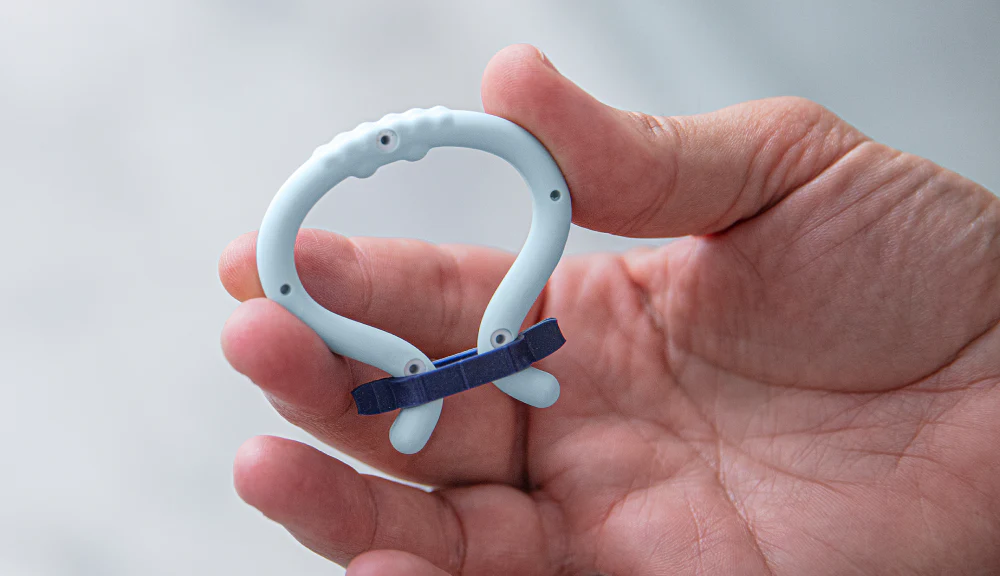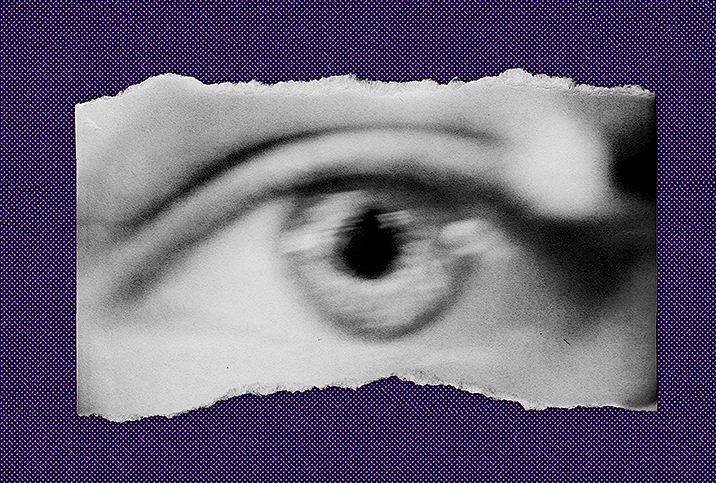Is EMDR an Effective Form of Birth Trauma Therapy?

Key Points
- Reproductive trauma and related mood disorders such as postpartum depression and anxiety are common.
- Because traumatic memories are stored differently than others, conventional talk therapy may not be sufficient for healing.
- Research suggests eye movement desensitization and reprocessing (EMDR) therapy may be a more effective method.
Kate Ecke's vision of a natural pregnancy and birth experience shattered when, at 35 weeks, she was told she needed an emergency C-section. Within minutes, a flurry of doctors, nurses and technicians frantically ripped off her gown. They inserted needles and a catheter. They asked a slew of questions as she screamed "I don't want to die" through excruciating pain.
"I remember the nurse looked at me and said, 'We're going to do our best," said Ecke, a licensed clinical social worker and founder of The Unconventional Therapists in Toms River, New Jersey.
She slipped into anesthesia, thinking neither she nor her baby would survive. She awoke hours later, alone and covered in blood.
Ecke, who specializes in trauma therapy, had for years used eye movement desensitization and reprocessing (EMDR) to treat clients with conditions such as post-traumatic stress disorder (PTSD).
Still, she had never heard the term "reproductive trauma" nor understood how EMDR might help until she experienced it herself.
What is reproductive trauma?
Ecke's doctor informed her she had experienced a complete placental abruption, which is almost always fatal for the mother, baby or both. Ecke's daughter, deemed a medical miracle, was perfectly healthy.
Her husband was elated; Ecke was bewildered. She had anticipated being overcome with love and adoration upon meeting her newborn. Instead, she felt nothing.
As a therapist, Ecke understood that much of what she felt in the first few weeks of her daughter's life could be attributable to shock, sleeplessness and fluctuating hormones. She knew how crucial her doting presence was to her daughter's development and dutifully went through the motions, despite feeling that the child wasn't hers.
"For weeks, I walked around waiting to give birth. I remember being out in Target with her, and she's in her car seat in the cart," Ecke said. "I remember thinking, 'I have to give birth soon. I wonder what that's going to be like.' Then I looked at her and was like, 'Oh my God, I did.' But it didn't feel like it because I wasn't there. I wasn't present for it."
After about a month, Ecke recognized she was struggling with severe postpartum depression and sought help from her therapist.
"He was like, 'I don't really know what to say.' And I said, 'Well, can we talk about what happened? Because I almost died, and she almost died, but I don't think I love her. I'm really angry,'" Ecke said. "He was like, 'I'm not equipped for this.' I felt like I'd been dropped on the pavement."
He recommended Ecke speak with someone specializing in reproductive trauma. It was the first time she'd heard the term.
"No one had ever talked to me about birth or reproductive trauma. In all the training I had gone through, it never came up," Ecke said. "Afterward, I was so angry at myself and the system that it had to happen to me to hear about it."
What are examples of reproductive trauma?
Reproductive trauma can result from any situation related to becoming a parent that causes significant distress or impedes a person's ability to function, said Hilary Bayley Loielo, M.S.S, L.C.S.W., a therapist at Whole Heart Reproductive Mental Health in Philadelphia.
Although trauma is typically defined as an event in which someone believes their life or someone else's is in danger, that's not always the case, Ecke said.
Examples of reproductive trauma include infertility, miscarriage, ectopic pregnancy, stillbirth, maternal or fetal distress, infant loss, unplanned C-sections or hysterectomies, and maternal injuries such as a perineal tear or hemorrhage, according to Rebecca Kase, L.C.S.W., a therapist and the founder of Kase & Co. in Gig Harbor, Washington.
"Reproductive trauma can also include inadequate communication with medical staff, lack of informed consent, lack of support, feeling powerless, and the loss of the birth experience the individual wanted or envisioned," said Elyse Rubio, L.C.S.W., a counselor at Helping Hands Psychotherapy in Rockville Centre, New York, and medical reviewer at the Roots of Loneliness Project.
Recommended
- Do You Have Trauma Stored in Your Hips?: Trauma can affect the body as much as the brain. If you're a survivor with hip or pelvic pain, certain exercises may help.
- Treatment of PTSD: Does PTSD go away? For some people, the symptoms dissipate within a few weeks. For others, they can linger for years without treatment.
- How to Advocate for Yourself During Childbirth: Labor and delivery don't always go according to plan, but speaking up may diminish the risk of a traumatic pregnancy and birth experience.
What's the link between RT and postpartum mood and anxiety disorders?
It's unclear how many people with reproductive trauma develop mental health complications, Kase said. Health providers have historically not been trained to screen for reproductive trauma, so there's little data on how significantly people are impacted, for how long and in what ways.
However, about 1 in 5 new mothers experience postpartum mood and anxiety disorders (PMADs), according to the Minnesota Department of Health.
These conditions include depression, anxiety, obsessive-compulsive disorder (OCD), bipolar disorder, PTSD, or psychosis that occur during pregnancy or in the first year after childbirth.
These disorders can be dangerous for parents and children. Their effects range from an increased risk of chronic disease to death by suicide, a 2021 report suggested. Their prevalence surged two- or threefold during the pandemic, according to a 2022 report.
Reproductive trauma can contribute to or exacerbate psychiatric disorders in people who haven't given birth, including those who've experienced infertility, miscarriage, ectopic pregnancy or unplanned pregnancy. Pregnant people's partners can be affected, too.
Kadi Buckmiller, a senior administrator in Spokane, Washington, first experienced reproductive trauma in her early 20s when she received a diagnosis of "unexplained infertility."
"This was a huge hit to me mentally, as it meant no one knew why I couldn't have children, and there was no clear line of action I could take," she said.
Her anxiety and depression intensified, and eventually, she sought help from a therapist who specialized in conventional talk therapy and EMDR.
"I told her all the issues I had around my fertility and self-worth, that I grew up thinking the only thing I could fully be good at was motherhood," she said. "Even if I didn't believe that fully (anymore), a part of me based a lot of my worth on it."
After three years of inner work and significant headway, Buckmiller experienced an ectopic pregnancy, which required the removal of her right fallopian tube and ovary. Her left fallopian tube, severely damaged by internal bleeding, was nonviable.
"On top of the physical and emotional trauma this all caused, the medical team took 12 hours to diagnose me with my ectopic, leading to sepsis and extreme blood loss," she said. "The work I had done to come to terms with my [infertility] diagnosis was out the door, and I had to suffer a whole new loss."
Again faced with crippling depression, she turned to her therapist and EMDR for help.
What happens during EMDR?
Psychologist Francine Shapiro developed EMDR in 1987 based on his theory of adaptive information processing (AIP). The concept hinges on the idea that the brain processes traumatic and nontraumatic events differently, and many trauma symptoms result from "maladaptive" memory storage, Rubio said.
"That simply means a memory is stored in a way that causes your nervous system to relive and re-experience the trauma, which leads to symptoms such as anxiety, flashbacks, nightmares, depression, intrusive thoughts and irritability, to name a few," Kase said.
EMDR identifies problematic memories and their associated emotional and physical effects, then uses bilateral stimulation to help the nervous system reprocess and integrate the memories more healthily, according to Kase. Doing so can lessen the memory's emotional intensity and charge.
Therapists typically accomplish bilateral stimulation by asking patients to move their eyes from side to side, following a light or hand. They can also do so by having a patient tap alternating sides of their body or hold vibrating buzzers.
The effect on the brain's neural networks is akin to that which occurs during REM sleep, Kase said.
'EMDR has been highly researched because it sounds so strange. We don't know exactly how EMDR works, but we don't know exactly how any therapy works, for that matter.'
It facilitates communication between the prefrontal cortex—it handles functions such as cognition, reasoning and impulse control—and the limbic system, which is more involved in the emotional and physical response, said Laura Rutledge, L.M.H.C., a licensed mental health counselor and therapist at GIA Miami in Florida.
"It's like giving your brain a gentle nudge in the right direction, helping it calibrate and find a healthier path forward," Kase said. "EMDR has been highly researched because it sounds so strange. We don't know exactly how EMDR works, but we don't know exactly how any therapy works, for that matter."
Talk therapy can be highly effective for overcoming many mental health challenges, Rutledge said, but it isn't always enough for trauma survivors.
"Trauma directly impacts not only how we view ourselves and the world, but our nervous systems," she added. "Talk therapy can help challenge how we view ourselves and the world but leaves our nervous systems stuck in the same fight, flight, freeze state."
Traumatic experiences are stored in implicit memory, which means it can be difficult for people to describe their experience or why they're feeling a particular way—a crucial component to talk therapy, Kase said.
Moreover, conventional talk therapy may be re-traumatizing for some people when they are asked to rehash memories at length. With EMDR, patients focus briefly on the traumatic memory while undergoing bilateral stimulation to diminish the memory's emotional impact.
"This helps the brain to process the memories that have been stuck in the neural network and resume the natural healing process," Rubio said. "It allows the brain to do what it innately knows how to do: heal."
How effective is EMDR?
Multiple reputable organizations, including the World Health Organization (WHO), the American Psychological Association (APA) and the National Alliance on Mental Illness (NAMI), have endorsed EMDR as an evidence-based, effective treatment for trauma and other psychiatric conditions.
These conditions include the following:
- PTSD
- Depression
- Anxiety
- Panic disorders
Women who underwent EMDR after a stillbirth had less anxiety during their subsequent pregnancy, a 2016 study suggested. EMDR reduced fear of childbirth in 72 percent of women with childbirth-related PTSD, according to a 2022 study.
Despite seeing the evidence, Buckmiller was skeptical when her therapist first proposed EMDR.
"I am vocal and verbal and feel a strong need to talk things out," she said. "I couldn't wrap my head around not speaking and still somehow resolving issues."
Danielle Erwin, a stay-at-home mother of five children in Manassas, Virginia, felt similarly. Erwin, who has had four miscarriages, first heard of EMDR while pursuing her master's degree in clinical psychology but doubted it could work for her.
After giving birth to four living children, Erwin miscarried for the first time due to a partial placental abruption. She then miscarried two more times before having her rainbow baby and a fourth time after following diagnoses of endometriosis and early menopause.
The traumas—individually and collectively—took a toll on her mental health. Eventually, at a friend's suggestion, she decided to try EMDR.
Like Buckmiller, Erwin had some meaningful success with other therapy modalities but found EMDR uniquely beneficial, and not at all what she'd expected.
"The experience was like none other," Erwin said. "I was amazed at the images that came every single time I tried it and how each image aided me in working through various traumas, not just miscarriage traumas."
What are the EMDR phases?
There are eight EMDR phases, Loielo and Kase said.
At first, it's much like conventional therapy. A therapist takes the patient's history, determines if EMDR is an appropriate approach for them, establishes a treatment plan, explores expectations, and fosters trust and security.
The therapist discusses coping skills to help the client with any emotional disturbances that may arise during the session and identifies specific memories the client wants to address.
The subsequent phases are devoted to processing memories with bilateral stimulation. These sessions typically last about an hour, though some therapists provide intensive sessions that span a few hours.
Therapists progress gradually, helping clients process more minor challenges—fear of highway driving, in Buckmiller's case—before moving on to more profound traumas.
The final phases entail associating positive beliefs and cognitions with the initial identified event, doing a body scan to check for lingering sensations and evaluating progress and goals, Loielo said.
How many EMDR sessions do I need?
The number of sessions needed can vary significantly from one person to another, according to Kase. Typically, people with less complex situations need 12 sessions or fewer, while people with more complicated challenges may need more.
Can you do EMDR virtually?
A vast majority of EMDR therapists are trained to practice virtually, Kase said. Research indicates it can be just as effective as in-person therapy, according to a 2021 report.
Can you do EMDR on yourself?
EMDR is not a DIY therapy, according to Rubio. The method allows the brain to heal itself, but it requires the presence of a qualified professional to guide, monitor, assess and intervene if necessary.
Even trained EMDR therapists don't do EMDR on themselves, Kase said.
"The provider who trained me often describes EMDR as clearing out an infection; it requires a trained expert to do it properly and avoid further injury," Rubio said.
You can use resources and coping strategies obtained from EMDR preparation phases for purposes such as grounding and emotional regulation, Rubio said.
The bottom line
EMDR helped Ecke to address the wounds associated with her pregnancy and birth experience and bond with her daughter in the ways she'd always dreamed she would. Still, three years later, she feels a heightened sense of anxiety "beyond the typical mom worry."
"There's this sense that the two of us met death together. It's almost this 'Final Destination' fear, like it must be coming for us in a different way. We shouldn't have survived," she said. "I don't know if that will ever go away."
It may not be possible to recover from trauma fully, Ecke said. Instead, it may be necessary to make space for it. Changing how you perceive and engage with it may help to alleviate suffering.
If you're grappling with trauma or other mental health challenges, you're not alone, you are not to blame, your feelings are valid and help is available.
"It doesn't matter how anyone else sees it. If your partner or spouse or whoever doesn't think what happened was traumatic, it doesn't matter," Ecke said. "If it felt traumatic, you deserve to address it."


















